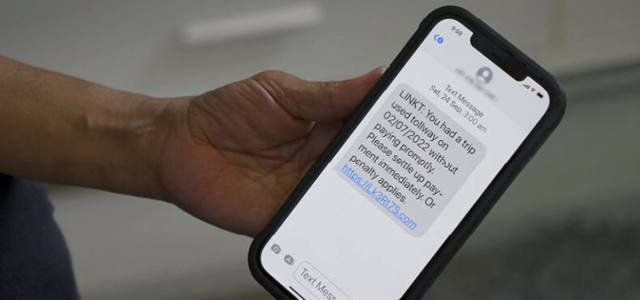SDC Rewards Member
Upgrade yours now
Warning for motorists: Watch out for this text message scam – here's how to protect yourself!
If you're a regular driver, there's a good chance you use an e-tag or similar electronic device to automatically register and pay for road tolls.
These devices are extremely convenient and make paying for tolls much easier, especially if you're travelling long distances. All you have to do is attach them to your windshield, and they'll take care of the rest!
But as useful as they are, scammers have found a way to exploit them in order to con unsuspecting Australians out of millions of dollars…
Here's what you need to know to protect yourself from becoming a victim.
It starts with a text message claiming an outstanding road toll that needs to be paid.
The amount owed is usually only a few dollars, so it doesn't seem like much at first glance. But if you click on the link provided in the message, it will take you to a fake website that looks almost identical to the real thing.
Once on this site, you enter your credit card details and hit 'submit'. And just like that, scammers will have access to your bank account and can quickly drain it dry!
We've heard reports of people losing thousands of dollars in just a matter of days because they fell for this simple trick.

Catherine Arrowsmith was fleeced for $8,000 after she paid a small $5 toll fine after getting a text. Credit: A Current Affair.
Catherine Arrowsmith, a young mother, is one example of this type of situation. She got a text message informing her that she owed a $5 toll fine, which she promptly paid with her credit card.
She reported that she even double-checked the website and found that it appeared to be real; yet, she was conned out of thousands of dollars. 'About two weeks later, they went and spent about $8,000 in Victoria, and I live in NSW,' she recalled her harrowing experience.
Ms Arrowsmith went on to express her disappointment that her bank had not immediately placed a hold on her card in response to the suspicious activity, which could have saved her thousands of dollars.
'They didn't put any stop on the cards. The transactions were for $2,500, another $900 at Coles, and another $900 at Woolies. I don't think I've ever spent $900 at Coles,' she said.
Andrew Engel fell prey to a similar con. Like many Aussie drivers, he also has a tag on his car for tolls.
Recently, he received a text message from Linkt, his toll collection company, informing him that a recent toll had not been filed and asking if he could pay the $5 toll to avoid a fine.
Even though the URL and associated link appeared to be legitimate, he was shocked his credit card was fraudulently charged $11,000.
'I go to bed at night, it's the last thing I think about; it's the first thing I think about when I wake up because it's such a large amount of money. It may as well have been a million,' said the 74-year-old pensioner, who lives on a limited income.
Mr Engel, like Ms Arrowsmith, was also upset that his bank did not put any kind of hold on his card even though the transactions were highly out of the norm for the customer who had been with the bank for decades.
While Ms Arrowsmith was fortunate in recouping a sizable portion of her losses through a bank dispute, Mr Engel's efforts were unsuccessful, and he was forced to pay the full amount of his losses on his credit card.
Key Takeaways
- Motorists should be aware of a scam targeting users of electronic toll-payment devices.
- Scammers send text messages asking for payment of an outstanding toll and then direct victims to a fake website where their credit card details are stolen.
- Thousands of Aussies have been hit by this scam, and once the criminals get their credit cards, they go shopping immediately.
'We are aware of an SMS phishing scam that is using Linkt, Transurban and other toll road brands,' they said.
'This is a significant issue across Australia – many different brands and companies are facing this challenge, and unsuspecting people are falling victim to scam text messages.'
'Our Cyber Security Operations team is working with telecommunications providers to identify and block phone numbers sending these texts. We have reported nearly 2000 unique scam messages to telecommunications providers so that they can block these and protect our customers and the Australian public.'
Tip
You can report a scam message to Linkt via their website at linkt.com.au or via the Federal Government's ScamWatch website at scamwatch.gov.au.
- Never reply to an email or SMS with your financial information or personal information. They said: 'If we need you to manage your account, we will always direct you to log into your account directly via linkt.com.au or the Linkt app.'
- If you receive a message from someone claiming to be Linkt or Transurban that doesn't seem quite right, don't click on the link. Some examples of what you may see in a scam text include incorrect spelling or strange URLs.
- Make sure you're logging into the Linkt website by navigating to linkt.com.au before you enter any personal details. You can also manage your account securely via the Linkt or LinktGO apps.
To stay informed about current fraud cases and phishing attacks, visit the Scam Watch forum on the SDC website. Stay safe always!







